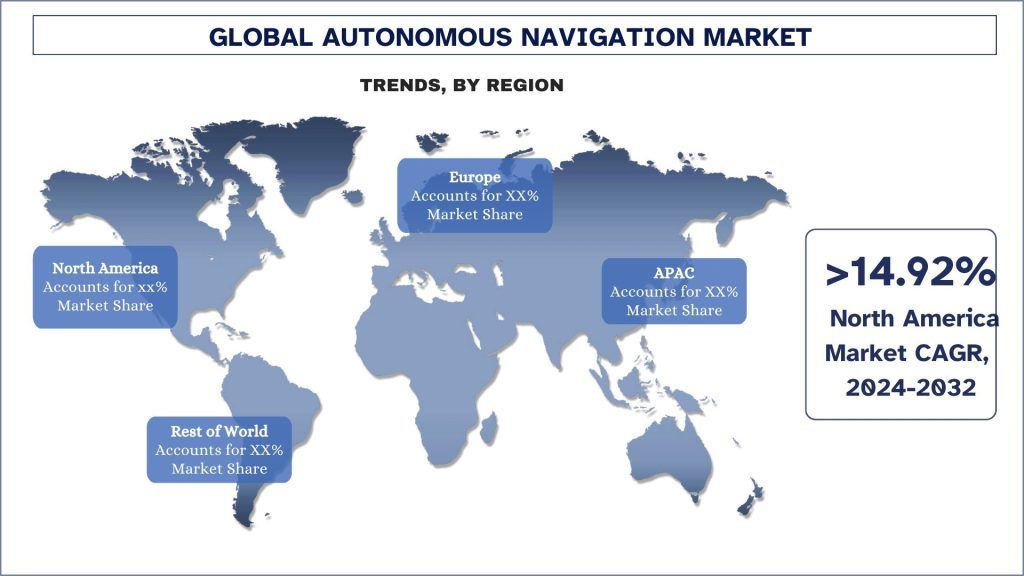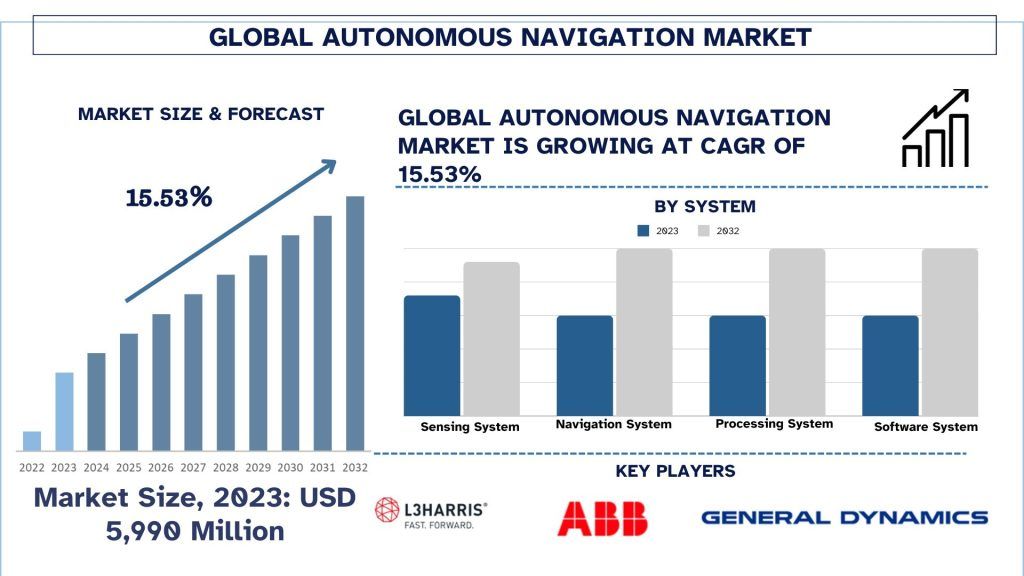- Home
- About Us
- Industry
- Services
- Reading
- Contact Us
Autonomous Navigation Market: Current Analysis and Forecast (2024-2032)
Emphasis on By Platform (Airborne, Land, Marine, Space, Weapon); By System (Sensing System, Navigation System, Processing System, Software System), By Application (Commercial, Military, Government), and Regions (North America (The US, Canada, Rest of North America), Europe (Germany, The UK, France, Italy, Spain, Rest of the Europe), Asia-pacific (China, Japan, India, Rest of the Asia-pacific), Rest of the World)
Global Autonomous Navigation Market Size & Forecast
The Global Autonomous Navigation Market was valued at USD 5990 million in 2023 and is expected to grow at a strong CAGR of around 15.56% during the forecast period (2024-2032) owing to rising demand for Autonomous Navigation in the aircraft industry across the globe.
Global Autonomous Navigation Market Analysis
Autonomous Navigation systems refer to the combination of sensors and software that help the platform to steer itself on a predetermined path and move autonomously. Many of the platforms including airborne, land-based, marine, space, etc., are extensively using these technologies to reduce the dependence on the onboard presence of a pilot/driver. These autonomous systems have helped revolutionize the military and defense sectors as well as the automotive and aerospace sectors by offering robust leaps in technological advancement through the integration of autonomous technologies.
The Global Autonomous Navigation market was valued at USD 5990 million in 2023 and is expected to grow at a strong CAGR of around 15.56% during the forecast period (2024-2032). One of the key sectors that has proven to be conducive to the growth of the autonomous navigation market is the higher demand for autonomous flights among both commercial and military jet categories. A large number of aviation companies are integrating commercial jets with autonomous flying capabilities known as autopilot. In recent years many of the large-scale commercial jet acquisition projects have been announced which would further promulgate the demand for autonomous navigation to the aerospace industry. For instance, in 2023, Air India formalized a deal for 470 Airbus and Boeing aircraft of which the first aircraft will be delivered from mid-2025. The deal consists of a combination of both widebody and narrowbody jets.
In another instance, in 2024, Israeli aviation company El AI announced to purchase of 31 Boeing 737 Max aircraft with a total cost of USD 2.5 billion. The company has announced to use the combination of narrowbody and widebody aircraft with the deliveries starting from the year 2028.
With the growing demand for aircraft with autopilot systems and self-navigation, the demand for autonomous navigation systems is anticipated to rise. The demand would further be supported through the growing sales of military jets and the demand from spacecraft technologies in the coming years i.e., 2024-2032.
Global Autonomous Navigation Market Trends
This section discusses the key market trends that are influencing the various segments of the Global Autonomous Navigation Market as identified by our team of research experts.
Collaboration between Automotive and Autonomous Technology Providers
Autonomous Systems are extensively being used in the automobile sector. With the rising demand for autonomous vehicles, many automotive companies have started integrating the hardware along with sensors such as radar, LIDAR, infrasonic sensors, software, and lane departure sensors to fully deploy driverless technology.
Both commercial vehicles and passenger cars are experiencing the same due to which the demand for the autonomous navigation system is high in demand. Many of the leading automobile companies such as Volkswagen, Skoda, Toyota, Suzuki, Tata, Mahindra, BYD, Tesla, etc., are not only investing heavily in adopting such technologies but are also looking forward to collaborating with the autonomous driving technology providers due to which the integration of such systems has become considerably easier for the companies.
Additionally, these updates have also paved the path for better product development and supporting the demand for autonomous navigation systems across the globe, especially in the regions high in the production of automobiles.
Considering the rising collaboration between autonomous technology providers and automotive companies, the demand for Autonomous Navigation market will grow during 2024-2032.

North America is Expected to Hold Major Market Share During Forecast Period
North America has held the major market share in the global autonomous navigation market. As the region is home to some of the largest aircraft manufacturing companies as Boeing, Bombardier, and Lockheed Martin the demand for autonomous navigation for the airborne category is on the higher side. Additionally, there is a rising demand for autonomous driving solutions in cars with the presence of large manufacturing units of Tesla, BYD, GM, etc. These companies extensively demand the hardware and software for self-driving cars further supporting the market growth.
Furthermore, the demand for autonomous navigation from the space and weapons category is also prominent as the country as the US has a full-scale operational space mission and is the largest purchaser and exporter of guided munition. Considering these the region is further anticipated to hold its prominent share in the demand for autonomous navigation systems.

Global Autonomous Navigation Industry Overview
The Global Autonomous Navigation market is competitive and fragmented, with the presence of several global and international market players. The key players are adopting different growth strategies to enhance their market presence, such as partnerships, agreements, collaborations, new product launches, geographical expansions, and mergers and acquisitions. Some of the major players operating in the market are L3Harris Technologies Inc., Safran, Moog Inc., Advanced Navigation, Elbit Systems Ltd, BAE Systems Ltd, Lockheed Martin Corporation, General Dynamics Corporation, and Raytheon Technologies Corporation.
Global Autonomous Navigation Market News
In 2024, Air China announced the purchase of 100 units from domestic aircraft manufacturing company Commercial Aircraft Corporation of China (COMAC). The order is anticipated to cost around USD 10.8 billion.
In 2024, September, Airbus announced it received an order of 85 aircraft with 10 A350 and 75 A320neo across the globe which is an increase from the years from the same period last year.
Global Autonomous Navigation Market Report Coverage

Reasons to buy this report:
- The study includes market sizing and forecasting analysis validated by authenticated key industry experts.
- The report presents a quick review of overall industry performance at one glance.
- The report covers an in-depth analysis of prominent industry peers with a primary focus on key business financials, product portfolios, expansion strategies, and recent developments.
- Detailed examination of drivers, restraints, key trends, and opportunities prevailing in the industry.
- The study comprehensively covers the market across different segments.
- Deep dive regional level analysis of the industry.
Customization Options:
The Global Autonomous Navigation market can further be customized as per the requirement or any other market segment. Besides this, UMI understands that you may have your own business needs; hence, feel free to connect with us to get a report that completely suits your requirements.
Table of Content
Research Methodology for the Global Autonomous Navigation Market Analysis (2024-2032)
Analyzing the historical market, estimating the current market, and forecasting the future market of the Global Autonomous Navigation market were the three major steps undertaken to create and analyze the adoption of Global Autonomous Navigation in major regions globally. Exhaustive secondary research was conducted to collect the historical market numbers and estimate the current market size. Secondly, to validate these insights, numerous findings and assumptions were taken into consideration. Moreover, exhaustive primary interviews were also conducted with industry experts across the value chain of the Global Autonomous Navigation market. Post assumption and validation of market numbers through primary interviews, we employed a top-down/bottom-up approach to forecasting the complete market size. Thereafter, market breakdown and data triangulation methods were adopted to estimate and analyze the market size of segments and sub-segments of the industry. Detailed methodology is explained below:
Analysis of Historical Market Size
Step 1: In-Depth Study of Secondary Sources:
A detailed secondary study was conducted to obtain the historical market size of the Global Autonomous Navigation market through company internal sources such as annual reports & financial statements, performance presentations, press releases, etc., and external sources including journals, news & articles, government publications, competitor publications, sector reports, third-party database, and other credible publications.
Step 2: Market Segmentation:
After obtaining the historical market size of the Global Autonomous Navigation market, we conducted a detailed secondary analysis to gather historical market insights and share for different segments & sub-segments for major regions. Major segments are included in the report as by Platform, by System, and by Application. Further regional/country-level analyses were conducted to evaluate the overall adoption of testing models in that region.
Step 3: Factor Analysis:
After acquiring the historical market size of different segments and sub-segments, we conducted a detailed factor analysis to estimate the current market size of the Global Autonomous Navigation market. Further, we conducted factor analysis using dependent and independent variables such as by Platform, by System, and by Application in the Global Autonomous Navigation market. A thorough analysis was conducted for demand and supply-side scenarios considering top partnerships, mergers and acquisitions, business expansion, and product launches in the Global Autonomous Navigation market sector across the globe.
Current Market Size Estimate & Forecast
Current Market Sizing: Based on actionable insights from the above 3 steps, we arrived at the current market size, key players in the Global Autonomous Navigation market, and market shares of the segments. All the required percentage shares split and market breakdowns were determined using the above-mentioned secondary approach and verified through primary interviews.
Estimation & Forecasting: For market estimation and forecast, weights were assigned to different factors, including drivers & trends, restraints, and opportunities available for the stakeholders. After analyzing these factors, relevant forecasting techniques, i.e., the top-down/bottom-up approach, were applied to arrive at the market forecast for 2032 for different segments and sub-segments across the major markets globally. The research methodology adopted to estimate the market size encompasses:
- The industry’s market size, in terms of revenue (USD) and the adoption rate of the Global Autonomous Navigation market across the major markets domestically
- All percentage shares, splits, and breakdowns of market segments and sub-segments
- Key players in the Global Autonomous Navigation market in terms of products offered. Also, the growth strategies adopted by these players to compete in the fast-growing market.
Market Size and Share Validation
Primary Research: In-depth interviews were conducted with the Key Opinion Leaders (KOLs), including Top Level Executives (CXO/VPs, Sales Head, Marketing Head, Operational Head, Regional Head, Country Head, etc.) across major regions. Primary findings were then summarized, and statistical analysis was performed to prove the stated hypothesis. Inputs from primary research were consolidated with secondary findings, hence turning information into actionable insights.
Split of Primary Participants in Different Regions

Market Engineering
The data triangulation technique was employed to complete the overall market estimation and to arrive at precise statistical numbers for each segment and sub-segment of the Global Autonomous Navigation market. Data was split into several segments and sub-segments after studying various parameters and trends by Platform, by System, and by Application in the Global Autonomous Navigation market.
The main objective of the Global Autonomous Navigation Market Study
The current & future market trends of the Global Autonomous Navigation market were pinpointed in the study. Investors can gain strategic insights to base their discretion for investments on the qualitative and quantitative analysis performed in the study. Current and future market trends determined the overall attractiveness of the market at a regional level, providing a platform for the industrial participant to exploit the untapped market to benefit from a first-mover advantage. Other quantitative goals of the studies include:
- Analyze the current and forecast market size of the Global Autonomous Navigation market in terms of value (USD). Also, analyze the current and forecast market size of different segments and sub-segments.
- Segments in the study include areas by Platform, by System, and by Application.
- Define and analyze the regulatory framework for global Autonomous Navigation industry.
- Analyze the value chain involved with the presence of various intermediaries, along with analyzing customer and competitor behaviors of the industry.
- Analyze the current and forecast market size of the Global Autonomous Navigation market for the major regions.
- Major countries of regions studied in the report include North America (The US, Canada, and Rest of North America), Europe (The UK, France, Germany, Italy, Spain, Rest of Europe), Asia-pacific (China, Japan, India, Rest of the Asia-pacific), Rest of the World
- Company profiles of the Global Autonomous Navigation market and the growth strategies adopted by the market players to sustain in the fast-growing market.
- Deep dive regional level analysis of the industry
Frequently Asked Questions FAQs
Q1: What is the current market size and growth potential of the Global Autonomous Navigation market?
Q2: What is the driving factor for the growth of the Global Autonomous Navigation market?
Q3: Which segment has the largest share of the Global Autonomous Navigation market by Platform?
Q4: Which region will dominate the Global Autonomous Navigation market?
Related Reports
Customers who bought this item also bought











